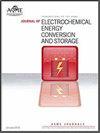Three-dimensional Heterogeneous Modeling of a Flexible Lithium-ion Battery Made from Semi-Solid Electrodes
IF 1.9
4区 工程技术
Q3 ELECTROCHEMISTRY
Journal of Electrochemical Energy Conversion and Storage
Pub Date : 2022-08-16
DOI:10.1115/1.4055222
引用次数: 0
Abstract
Flexible lithium-ion batteries (LIBs) have a strong oncoming consumer market demand for use in wearable electronic devices, flexible smart electronics, roll-up displays, electronic shelf labels, active radio-frequency identification tags, implantable medical devices, and so forth. This market demand necessitates research and development of new flexible LIBs to fulfill the electrical energy and power requirements of these next-generation devices. In this study, we investigate the performance of a new flexible LIB made from semi-solid electrodes. The semi-solid electrodes are made by adding a mixture of electrode active material and conductive material to the organic liquid electrode. This gives a dense and viscous slurry so that all solid particles can move by acting pressure, shear, or bending forces to the battery. To study the performance of this battery we develop a 3D heterogeneous mathematical model that considers all necessary transport phenomena including the charge and mass transfer and electrochemical reactions at the continuum mechanics level on the reconstructed 3D structure of semi-solid electrodes. The finite element analysis (FEA) method was used to solve the governing equations using the COMSOL Multiphysics software package. The model is validated using experimental data for the flexible LIB made in the lab. Based on the developed model, several studies are conducted to understand the effect of the battery discharge rate and the operating temperature on the battery capacity. These studies recommend an operational range for the temperature and discharge rate for this flexible LIB.半固体电极柔性锂离子电池的三维非均匀建模
柔性锂离子电池(LIBs)在可穿戴电子设备、柔性智能电子产品、卷式显示器、电子货架标签、有源射频识别标签、植入式医疗设备等领域有着强劲的消费市场需求。这种市场需求需要研究和开发新的柔性LIB,以满足这些下一代设备的电能和功率需求。在本研究中,我们研究了一种由半固态电极制成的新型柔性LIB的性能。半固体电极是通过将电极活性材料和导电材料的混合物添加到有机液体电极中而制成的。这会产生致密粘稠的浆料,因此所有固体颗粒都可以通过对电池施加压力、剪切力或弯曲力来移动。为了研究这种电池的性能,我们开发了一个三维非均匀数学模型,该模型考虑了所有必要的传输现象,包括电荷和质量转移以及在半固态电极重建的三维结构上的连续力学水平上的电化学反应。有限元分析(FEA)方法用于使用COMSOL Multiphysics软件包求解控制方程。使用实验室制作的柔性LIB的实验数据对该模型进行了验证。基于所开发的模型,进行了几项研究,以了解电池放电速率和工作温度对电池容量的影响。这些研究建议了这种柔性LIB的温度和放电速率的操作范围。
本文章由计算机程序翻译,如有差异,请以英文原文为准。
求助全文
约1分钟内获得全文
求助全文
来源期刊

Journal of Electrochemical Energy Conversion and Storage
Engineering-Mechanics of Materials
CiteScore
4.90
自引率
4.00%
发文量
69
期刊介绍:
The Journal of Electrochemical Energy Conversion and Storage focuses on processes, components, devices and systems that store and convert electrical and chemical energy. This journal publishes peer-reviewed archival scholarly articles, research papers, technical briefs, review articles, perspective articles, and special volumes. Specific areas of interest include electrochemical engineering, electrocatalysis, novel materials, analysis and design of components, devices, and systems, balance of plant, novel numerical and analytical simulations, advanced materials characterization, innovative material synthesis and manufacturing methods, thermal management, reliability, durability, and damage tolerance.
 求助内容:
求助内容: 应助结果提醒方式:
应助结果提醒方式:


